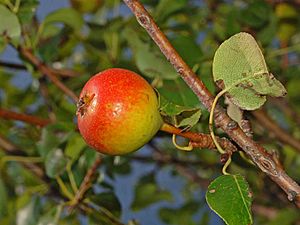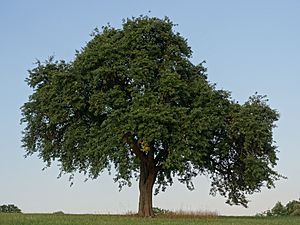Pyrus pyraster facts for kids
Quick facts for kids Pyrus pyraster |
|
|---|---|
 |
|
| Fruit of Pyrus pyraster | |
| Scientific classification | |
| Genus: |
Pyrus
|
| Species: |
pyraster
|
| Synonyms | |
|
|

The European wild pear (scientific name: Pyrus pyraster) is a type of pear tree. It belongs to the Rosaceae family, which also includes roses and apples. You might also hear it called Pyrus communis subsp. pyraster.
Scientists believe this wild pear, along with another type called Pyrus caucasica, are the ancestors of the common pear we eat today (Pyrus communis subsp. communis). This means they are like the great-grandparents of the pears you find in stores! Wild pears can easily mix their genes with cultivated pears.
It can sometimes be tricky to tell a wild pear tree from a regular pear tree. Wild pear trees can live for a very long time, often between 100 and 150 years.
Contents
What Does the Wild Pear Tree Look Like?
The European wild pear is a deciduous plant. This means it loses its leaves every autumn. It can grow as a medium-sized bush, reaching about 3 to 4 meters (10 to 13 feet) tall. It can also grow into a tree, reaching 15 to 20 meters (49 to 66 feet) tall.
Unlike the pear trees grown in gardens, wild pear branches have thorns. Its leaves are shaped like an oval with jagged edges. The flowers are white and bloom from April to May. The parts of the flower that hold pollen (called stamens) are about the same length as the central part (called styles).
The fruits are small, usually 1 to 4 centimeters (0.4 to 1.6 inches) across. They ripen in late summer or early autumn. These wild pears are quite hard and have a sharp, bitter taste when first picked. However, they become sweet and edible once they are very ripe and fall from the tree. The seeds inside the fruit are ready in September.
Wild pear trees often have a tall, slender shape with a crown that reaches upwards. This is especially true when they grow in good conditions. If conditions are not as good, they might look different, perhaps with a crown that leans to one side or is very low.
Where Do Wild Pears Grow?
Wild pear trees can be found across a wide area, from Western Europe all the way to the Caucasus mountains. However, you won't find them growing naturally in Northern Europe. Sadly, the wild pear has become quite rare in many places.
Sometimes, the wild pear grows in the same areas as other pear species, like Pyrus elaeagrifolia. They can also mix with other pear types to create new kinds of pears. For example, Pyrus austriaca is a mix of Pyrus pyraster and Pyrus nivalis.
What Kind of Places Do Wild Pears Like?
Wild pear trees can grow in almost any type of soil. The only soils they don't like are those that are very acidic. They aren't very good at competing with other plants for space. Because of this, you often find them in difficult or less ideal spots where other plants don't grow well.
These trees have deep main roots (called tap roots). This helps them find water deep underground, allowing them to grow even in very dry soils. Wild pear trees need a lot of sunlight, so they are often found in open areas. They can be seen in thick bushes or open forests in places with cool, mild weather. They grow in lowlands, on hills, and sometimes in mountains, from sea level up to about 1,400 meters (4,600 feet) high.
Wild Pears in Britain
The "wild pears" found in England and Wales are actually thought to be pear trees that escaped from gardens or farms. They are believed to have been brought to Britain a very long time ago by early farmers. Evidence like charcoal and seeds has been found at ancient sites. It's likely that these pears spread into the wild after people started growing them.
These British "wild pears" are probably types of the common cultivated pear (Pyrus communis) that have gone wild. They are not the true European wild pear (P. pyraster), which is native to mainland Europe but not to Britain.
Another type of wild pear found in South West England is the Plymouth pear (Pyrus cordata). Scientists now think this pear came from hedging plants that were brought over from Brittany, a region in France.
Gallery
See also
 In Spanish: Peral silvestre para niños
In Spanish: Peral silvestre para niños








